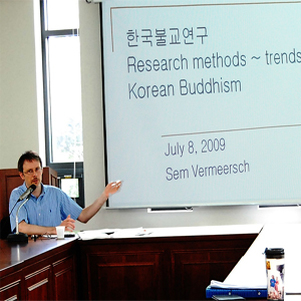|
“Christianity is foreign to Korea; Buddhism is native; it’s a shame that Christians have so much power in today’s Korea while Buddhism, Koreans’ ancestral faith, is so relatively weak…”
I imagine that many foreign observers of today’s Korea have had thoughts like this. Yet these same people, if they have been to Korea, will notice a distinct lack of temples in the cities. They big temples, and the old ones, are all hidden away in the mountains. Why is this? (Jared Way, whom I consider to be a kind of amateur expert on Buddhism in his own right, pointed this out to me.) A recognized expert on Korean Buddhism, Sem Vermeersch, was interviewed and had some surprising remarks relevant to this issue, which suggest that the impression people have (noted above in italics) may be rather misguided. Buddhism was marginal in Korea for centuries, with monks even banned from entering any city. (Explaining why the great temples of Korea are never in cities.) It seems that Korean Buddhism was marginal in the 1800s and then totally reinvigorated by Japanese contact. Just as Korean Christianity owes it all to the White missionary families who started showing up in the 1880s, Korean Buddhism owes, in perhaps comparable measure, to the Meiji Japanese. Both Korean Christianity and Korean Buddhism are products of the period of cultural shock by which a semi-medieval Chosun Dynasty stumbled its way into the modern world (yanked and shoved along the way). Here is the relevant part of interview, transcribed by me: |
Professor Sem Vermeersch (Seoul National University): Yes, that’s right. […] [From the 1600s-1800s in Korea,] Buddhism was tolerated. No one would confiscate their property. This didn’t happen anymore [after the suppressions of the 1400s-1500s]. Buddhism was left to its own devices but they were allowed to exist. Temples were taxed. They had to pay heavy taxes but they could at least maintain themselves. In the late 19th century, very slowly foreigners began to seep into the country. Of course, the Japanese were the most prominent of these. We all know the story of how Catholicism came to Korea, how Western missionaries started coming in the 1890s, but actually as soon as the treaty between Korea and Japan was inked in 1876, the year after already the Japanese opened a Buddhist temple in Busan. I think it was 1877. So very quickly, the Japanese were here to spread their own forms of Buddhism. Initially, they cooperated very well with the Korean Buddhist monks. There’s a very famous example of a Japanese Buddhist monk who “lobbied” the Korean government to overturn the ban on Buddhist monks entering the cities. That was, I think, in 1895. King Kojong allowed monks to open temples in Seoul and to go into the cities as monks. Before that, if they wanted to enter the city they had to dress up, disguise themselves, as something different. So in 1895, Buddhist monks were allowed to enter the cities, and that allowed them to spread “Dharma” again among the people. So initially they looked up, very much, to these Japanese monks.
Interviewer: They ended a four hundred year ban, so —
Professor Sem Vermseersch: Exactly.
Interviewer: That’s quite something.
Professor Sem Vermseersch: So they were very grateful, actually. Not only that, but they also saw that Japanese Buddhist monks, apparently, had a lot of influence, lots of financial means, that they apparently had a very strong position in their own country, so Korean Buddhist monks basically wanted to follow the Japanese model, and learn about other cultures through these Japanese Buddhist monks. There is the famous case of the leader of Korean Buddhism at the beginning of the colonial period, 1909 or 1910. He made a secret pact with the Japanese that Japanese and Korean Buddhism would merge. […] Up to that point, there was a lot of goodwill amongst Korean Buddhists towards the Japanese, but when it became known that he had made this secret pact…There was a huge uproar.
[From Korea and the World podcast, recorded December 2014] [22:25-26:10]


